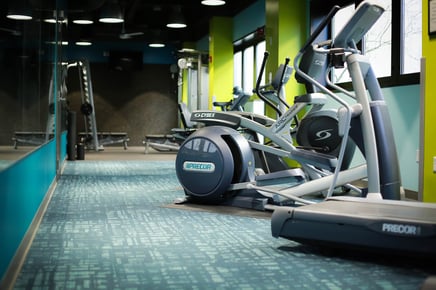 There are a variety of reasons for you, as a business owner, to set up a corporate fitness center for your employees; employee recruitment and retention are certainly among them. Increasingly, access to some form of exercise at work is becoming an expectation. It’s also not unreasonable to build a corporate fitness center because you actually expect it will help your employees be more active, which can lead to a variety of individual health benefits and possibly some productivity and loyalty benefits for the business.
There are a variety of reasons for you, as a business owner, to set up a corporate fitness center for your employees; employee recruitment and retention are certainly among them. Increasingly, access to some form of exercise at work is becoming an expectation. It’s also not unreasonable to build a corporate fitness center because you actually expect it will help your employees be more active, which can lead to a variety of individual health benefits and possibly some productivity and loyalty benefits for the business.
But establishing a corporate fitness center for your employees is not an “if you build it, they will come” phenomenon. After all, only about 15–17% of the U.S. population owns a gym membership. If you want your employees to have opportunities to exercise, dedicating some space on campus for exercise is a good first step, but it’s not the end of the story. Following is a checklist of steps you need to carefully consider to avoid an empty corporate fitness center and ensure your fitness center is set up for success, both for your business and for your employees.
Do you have the right collection of equipment and amenities in your fitness center?
I've seen corporate fitness centers that run the gamut from fairly bare-bones to spaces that would rival high-end clubs. Fancy matters much less than function. If you don't intend to provide expert staff in the space, you need to have equipment that your employees can use without instruction. Some of the newer functional training equipment isn't all that intuitive; be careful what you buy or only the most sophisticated exerciser will be able to put your equipment to effective use.
If you want to offer group fitness classes in your space, you'll need to have enough room to host the classes; consider 40–60SF per participant (don't forget to count the instructor!). Also keep in mind that your classes will increase volume in the fitness center and you'll want your locker room spaces to accommodate those peak-use times fairly well. With 28 years in the business, I can assure you that employees will stop coming if the locker room situation involves fighting for space.
Do you have the right leadership for the corporate fitness space/programs?
The single best way to maximize employee use of your corporate fitness center is to provide staff who manage the environment. Yes, there is a cost for that, but before you assume you don't want to pay it, consider the ramifications because here's how it plays out. Without staff to support and educate employees, the same 10% of your employees who exercise now are the ones who will use your fitness center. And the employees you're really trying to serve won't try something new in your corporate fitness space because they aren't sure what steps to take.
So committing to the fitness center space but not the fitness center staffing is building a gym for the employees who are exercising anyway. That's a pretty substantial investment for the employees who don't really stand to benefit from it.
Finding the right corporate fitness management partner doesn't have to be hard, and before you assume hiring out for that role is a horrible idea, check out this blog that addresses common misconceptions on outsourcing corporate fitness management. If you're still convinced your business is better off managing your fitness program in house, here are some suggestions for hiring your own corporate fitness manager.
Do you have a healthy culture that supports employees choosing to exercise during their time at work?
Employees spend more time commuting to and from work and actually at work than they spend anyplace else. Inviting them to exercise while they're already at the office may be our best hope for helping adults move more. But if taking a full 60-minute lunch break to work out is frowned upon by management, your corporate fitness center will stay mostly empty. If employees don't see their leadership making healthy choices a priority, your fitness center will remain a ghost town. It's not enough to have "break-time" policies written into your handbook. You have to lead by example and you have to make it okay for your management team to engage in the behaviors you want to see.


 According to a study published in the
According to a study published in the 
 Unless you live under a really, really big rock, you have no doubt heard about the importance of robust wellness opportunities as central to a successful senior living community. There have been some fabulous profiles lately on organizations that are doing an amazing job of connecting their residents and others in the surrounding areas to opportunities to live well. Two recent examples highlighted by
Unless you live under a really, really big rock, you have no doubt heard about the importance of robust wellness opportunities as central to a successful senior living community. There have been some fabulous profiles lately on organizations that are doing an amazing job of connecting their residents and others in the surrounding areas to opportunities to live well. Two recent examples highlighted by 
 We’ve all learned that exercise can play an enormous role in lowering one’s stress level and boosting a person’s mood. Supervisors in the workforce are no different—regular exercise has been shown to help those in management roles more effectively cope with their stressors.
We’ve all learned that exercise can play an enormous role in lowering one’s stress level and boosting a person’s mood. Supervisors in the workforce are no different—regular exercise has been shown to help those in management roles more effectively cope with their stressors. One of my favorite things to do in Indiana is to visit the various farmers’ markets around town. As a dietitian I am a sucker for the fresh fruits and veggies but I also love the homemade desserts, candles, pasta, kettle corn, fresh flowers, and other wonderful items you can find. Here are my top five reasons why visiting your local farmer’s market is a must.
One of my favorite things to do in Indiana is to visit the various farmers’ markets around town. As a dietitian I am a sucker for the fresh fruits and veggies but I also love the homemade desserts, candles, pasta, kettle corn, fresh flowers, and other wonderful items you can find. Here are my top five reasons why visiting your local farmer’s market is a must. Flexible working conditions not only have been found to reduce employee blood pressure and absences due to illness, but can increase job performance, productivity, and overall morale. Additionally,
Flexible working conditions not only have been found to reduce employee blood pressure and absences due to illness, but can increase job performance, productivity, and overall morale. Additionally, 
 find their employees' monetary sweet spots when it comes to losing weight. Various articles such as
find their employees' monetary sweet spots when it comes to losing weight. Various articles such as  being physically active--up to 34.7 percent compared with 31.9 percent in 2008. This is also good news; moving more can’t be bad.
being physically active--up to 34.7 percent compared with 31.9 percent in 2008. This is also good news; moving more can’t be bad.  I know it can be difficult to target programs toward children, especially if you have age restrictions at your onsite fitness center. One of the things
I know it can be difficult to target programs toward children, especially if you have age restrictions at your onsite fitness center. One of the things